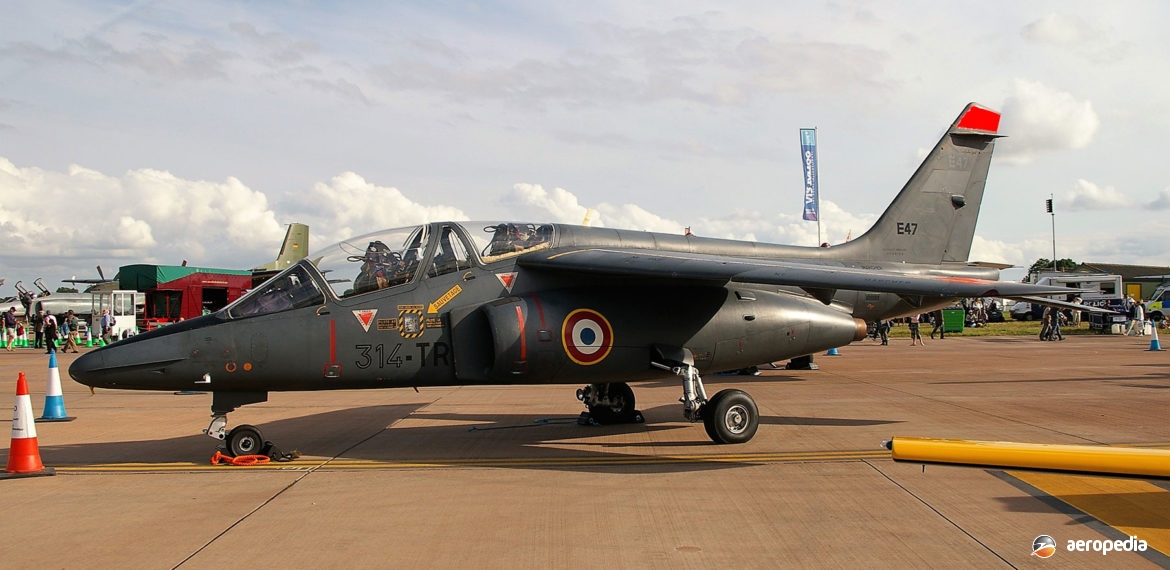Photograph:
A Dassault – Dornier Alpha Jet at the RIAT airshow in the United Kingdom in 2007 (John Tulloch)
Country of origin:
France / Germany
Description:
Two-seat military primary trainer
Power Plant:
Two 2,976 lbst SNECMA Turbomeca Larzac 04-C5 turbofans
Specifications:
- Wingspan: 9.11 m (29 ft 10¾ in)
- Length: 13.23 m (43 ft 5 in)
- Height: 4.19 m (13 ft 9 in)
- Wing area: 17.5 m² (188.4 sq ft)
- Max speed at sea level: 1,000 km/h (621 mph)
- Max speed at 10,000 m (32,810 ft): 916 km/h (569 mph)
- Stalling speed flaps and undercarriage down: 167 km/h (104 mph)
- Combat radius in lo-lo-lo profile: 610 km (379 miles)
- Service ceiling: 14,630 m (48,000 ft)
- Rate of climb: 3,420 m/min (11,220 ft/min)
- Climb to 9,150 m (30,020 ft): 7 mins
- Ferry range: 2,940 km (1,827 miles)
- Take-off run at normal weight: 370 m (1,215 ft)
- Landing run at normal weight: 500 m (1,640 ft)
- Empty weight: 3,515 kg (7,750 lb)
- Loaded weight: 5,000 kg (11,000 lb)
- Max take-off weight: 7,500 kg (16,535 lb)
History:
In the 1960s France and Germany worked together to jointly develop and produce an advance jet trainer, with a light attack variant, for service with their air forces and this involved the production of 200 aircraft for each service. A number of projects were put forward and the Alpha Jet resulted from the Breguet 126 and Dornier P.375 designs, the aircraft to have shoulder-mounted swept wings, stepped tandem cockpits and twin engines. French production was by Dassault, that Company having taken over Breguet by that time.
Development of the design was approved in February 1972 and two prototypes were ordered, the first prototype (F-ZJTS) first flying at Istres in France on 26 October 1973, followed by the second (D-9594 / F-ZWRU) at Oberpfaffenhofen, Germany on 9 January 1974. First production aircraft was flown on 4 November 1977. French aircraft entered service in November 1977 and the French aerobatic team, the Patrouille de France, was equipped with 12 examples.
German production commenced with Dornier Flugzeugwerke in April 1978, the last being delivered in January 1983. Some were delivered to Portugal. Other operators included Belgium, Cameroon, Egypt, Ivory Coast, Morocco, Nigeria, Qatar and Togo. Some 480 examples were completed.
Variants included the Alpha Jet A, an attack model for Germany; Alpha Jet E, a trainer variant for France and Belgium; Alpha Jet 2 optimised for ground attack; Alpha Jet MS1 a close support model assembled in Egypt; Alpha Jet MS2 with new avionics, up-rated engines and air-to-air missiles; and Alpha Jet ATS for advanced training with a glass cockpit.
In March 2017 it was announced by the Australian Government that Air Affairs Australia and Discovery Air Defence Services had teamed up to provide three Alpha Jets for Australian Defence Force training. Air Affairs Australia has been an aviation operations and engineering based company which was established in 1995 providing aircraft operations and maintenance under full CASA certification and has been based at the Albatross Aviation Technology Park at Nowra, NSW. It has owned and has operated a fleet of special mission Learjet and King Air aircraft providing specialised air training support services to the Australian Defence Force. These services have also included special mission roles, including turn-key high-altitude bushfire reconnaissance services.
Three Alpha Jet aircraft were imported under the existing Air Affairs Jet Support contract and commenced service in late 2017, these being ex-German Air Force aircraft which were operated in Australia with their Canadian registrations, being C-GITA (serial 040), C-GJTA(serial 057) and C-GLTO (c/n 069). These three fully-crewed and maintained Alpha Jets were at times based at RAAF Williamtown, NSW to provide ‘Joint Terminal Attack Controller’ training for the Australian Army and anti-surface training for the Royal Australian Navy. Operations, maintenance and logistics for the aircraft were carried out at the Albatross Aviation Technology Park at Nowra and at Williamtown.
Discovery Air Defence was a company based in Montreal, Quebec in Canada and contracted airborne training services to the Canadian Armed Forces through a contract airborne training services program. It had a fleet of aircraft to provide ‘Red Air’ threat replication, joint terminal attack control training, practise munitions drop, air-to-air gunnery training and naval target tow profiles for Canadian, US and German military forces. It also provided electronic warfare training and tactics development. The company was founded in 2000 by three former RCAF McDonnell Douglas CF-18 Hornet pilots. It had a fleet of 16 Dassault – Dornier Alpha Jets, seven single-seat Douglas A-4N Skyhawks, two Douglas TA-4J Skyhawks and an IAI Westwind 1124.
On 14 November 2017 Discovery Air Defence announced it had flown its first fast-jet training mission in support of the Australian Defence Force’s Fast Jet Trial contract. Two Alphas of Discovery Air Defence and four Learjets of Air Affairs participated in air-to-air missions as ‘Red Air’ aggressors near RAAF Williamtown, NSW, the aircraft participating in the RAAF’s No 81 Wing work-ups for future exercises.
In July 2019 C-GITA and C-GTLO (serials 040 and 069) operated out of RAAF Tindal in the Northern Territory during exercise ‘Diamond Storm’. The Alphas had been contracted to provide adversary training as ‘Red Air’ for the RAAF Joint Terminal Attack Controller training for the Australian Army, and support training for the RAN. At the end of the contract these two aircraft were flown to Nowra where they were dismantled and shipped back to Canada. The third aircraft (serial 057) was dismantled at RAAF Williamtown in February 2019 and returned to Canada.

